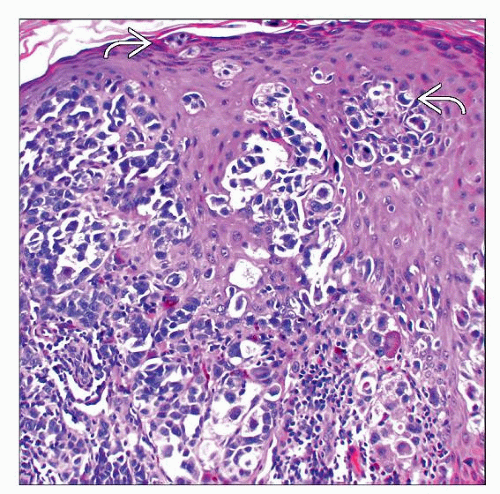Atypical/Borderline and Malignant Spitz Tumors
David Cassarino, MD, PhD
Key Facts
Terminology
Atypical Spitz tumor (AST)
Spitz tumor of borderline/uncertain malignant potential
Spitzoid melanoma
Clinical Issues
Mostly young patients, age range: 2-30 years
Prognosis difficult to predict
Most patients have a good prognosis, with only a minority of cases progressing to systemic disease or death
Microscopic Pathology
Severely atypical/borderline Spitz tumor
Typically, large and deep cellular compound melanocytic tumors
May appear symmetric and well-circumscribed at low power
Cells show severe cytologic atypia with nuclear hyperchromasia, enlarged nucleoli, irregular chromatin, and abundant amphophilic or dense eosinophilic cytoplasm
Mitotic figures often present, increased compared to conventional Spitz nevi
Spitzoid melanoma
Also large and deep tumors
Frank atypia and pleomorphism present
Junctional component often shows irregular nesting, confluence, and prominent pagetoid upward scatter
Multiple mitotic figures usually present
Often atypical &/or deep
TERMINOLOGY
Abbreviations
Atypical Spitz tumor (AST)
Synonyms
Atypical spitzoid melanocytic proliferation
Spitz tumor of borderline/uncertain malignant potential
Spitzoid melanoma
Definitions
Atypical/borderline Spitz tumor: Severely atypical melanocytic proliferation with features intermediate between benign Spitz nevus and spitzoid melanoma
Spitzoid melanoma: Malignant melanocytic proliferation with spitzoid features
ETIOLOGY/PATHOGENESIS
Unknown
Typically occur in young patients without any known risk factors for melanoma
Sun exposure may be a risk factor in some cases
Possible Genetic Role
Suggested by chromosome 11p amplification in a minority of cases
CLINICAL ISSUES
Epidemiology
Incidence
Very rare tumors
Age
Mostly young patients, range: 2-30 years
Malignant tumors more common in post-puberty age group
Presentation
Dermal papule or nodule
Treatment
Surgical approaches
Complete and wide excision is standard therapy
Typically ≥ 5 mm clinical margins for atypical/borderline tumors
Spitzoid melanomas should be treated with same margins as invasive melanomas of similar Breslow depth
Sentinel lymph node biopsy is highly controversial
Should be considered a prognostic rather than therapeutic procedure at this time
Likely should not be routinely used (especially for atypical/borderline tumors) until validated by extensive clinical studies
Prognosis
Difficult to predict
Most patients have relatively good prognosis, with only a minority of cases progressing to death
Even patients with lymph node involvement have a relatively good prognosis, as most tumors do not disseminate further
Stay updated, free articles. Join our Telegram channel

Full access? Get Clinical Tree






